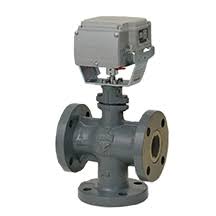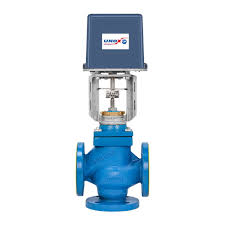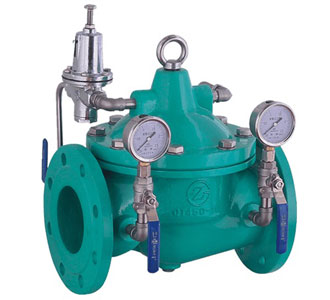2″150LB Motorized 3-Way Control Valve

The Application of Motorized 3-Way Control Valve
Introducing Cameron’s innovative solutions in fluid control with the Motorized 3-Way Control Valve. As a leading Motorized 3-Way Valve Manufacturer, Cameron offers top-quality products tailored for various applications. Whether for HVAC systems, industrial processes, or water treatment plants, our valves provide precise regulation of fluid flow. With Cameron, you can trust the reliability and efficiency of our products. Explore our range today and discover competitive 3-Way Motorized Control Valve Price options. Simplify your projects with Cameron, your trusted partner in fluid control solutions.
What Are The Types Of Motorized 3-Way Control Valve?
- Mixing Valves: These valves regulate the mixing of two different fluids to achieve a desired temperature or composition. They are commonly used in HVAC systems and water temperature control applications.
- Diverting Valves: Diverting valves control the flow of fluid between two different outlets. They are often used in process control systems to redirect flow to different process lines or equipment.
- Proportional Valves: Proportional control valves modulate the flow of fluid based on an input signal, allowing for precise control over flow rate or pressure. They are used in applications requiring fine-tuned control, such as in chemical processing or laboratory equipment.
- Multi-Function Valves: Some Motorized 3-Way Control Valves are designed to perform multiple functions, such as mixing, diverting, and shut-off, in a single valve body. These valves offer versatility and space-saving benefits in complex fluid control systems.
- Zone Valves: Zone valves are commonly used in HVAC systems to control the flow of fluid to different zones or areas within a building. They can be motorized to provide automated control over heating or cooling distribution.
What Is Motorized 3-Way Control Valve?
A Motorized 3-Way Control Valve is a type of valve equipped with an electric actuator that regulates the flow of fluid among three ports. It offers precise control over fluid distribution, allowing for versatile applications in HVAC systems, industrial processes, and water treatment plants. The electric actuator enables automated operation, facilitating remote control and integration into control systems for efficient fluid management. Motorized 3-Way Control Valves are essential components in fluid control systems, providing reliable performance and flexibility in fluid flow regulation.
How to Select the Right Motorized 3-Way Control Valve?
Selecting the right Motorized 3-Way Control Valve involves considering factors such as the flow requirements, pressure ratings, fluid compatibility, and system integration. Evaluate the specific needs of your application and consult with manufacturers to ensure compatibility and optimal performance. Additionally, consider factors like actuator type, valve material, and control system compatibility to ensure seamless integration and reliable operation.
Features of Motorized 3-Way Control Valve
- Versatility: Offers versatile fluid distribution among three ports, allowing for various flow configurations.
- Precision Control: Provides precise regulation of fluid flow rate and pressure, ensuring accurate system performance.
- Automation: Equipped with an electric actuator for automated operation, facilitating remote control and integration into control systems.
- Compact Design: Features a compact and space-saving design, ideal for installations with limited space availability.
- Durable Construction: Constructed from high-quality materials for durability and reliability in demanding environments.
- Flexible Application: Suitable for a wide range of applications including HVAC systems, industrial processes, and water treatment plants.
- Easy Installation: Designed for easy installation and maintenance, minimizing downtime and ensuring smooth operation.
- Energy Efficiency: Optimizes energy consumption through efficient fluid flow regulation, contributing to reduced operational costs.
- Compatibility: Compatible with a variety of control systems and accessories for enhanced functionality and performance.
- Safety Features: Incorporates safety features such as fail-safe modes or overload protection for reliable operation and system protection.
Advantages and Disadvantages of Motorized 3-Way Control Valve
Certainly, here are the advantages and disadvantages of Motorized 3-Way Control Valves presented point by point:
Advantages:
- Versatility: Provides versatile fluid distribution among three ports, allowing for various flow configurations.
- Precision Control: Offers precise regulation of fluid flow rate and pressure, ensuring accurate system performance.
- Automation: Equipped with an electric actuator for automated operation, facilitating remote control and integration into control systems.
- Space Efficiency: Features a compact design suitable for installations with limited space availability.
- Durable Construction: Constructed from high-quality materials for durability and reliability in demanding environments.
- Flexible Application: Suitable for a wide range of applications including HVAC systems, industrial processes, and water treatment plants.
- Energy Efficiency: Optimizes energy consumption through efficient fluid flow regulation, contributing to reduced operational costs.
Disadvantages:
- Initial Cost: Generally has a higher initial investment compared to manual valves.
- Complexity: Requires expertise for installation, setup, and maintenance.
- Dependence on Power: Relies on electricity for operation, making it susceptible to power outages.
- Potential Failure: May experience issues with electronic components, leading to downtime.
- Compatibility: Compatibility with existing systems and control infrastructure may be a consideration.
- Limited Response Time: Response time may be affected by system latency or communication delays.

The Specifications of Motorized 3-Way Control Valve
| Specification | Details |
|---|---|
| Type | Motorized 3-Way Control Valve |
| Ball Material | Stainless Steel |
| Attachment Type | Flanged |
| Thread Standard | N/A |
| Thread Size | N/A |
| Body Material | Brass |
| Safe for Use With | Water, HVAC fluids, chemicals |
| Handle Type | Electric Actuator |
| Handle Material | N/A |
| Maximum Working Pressure | 150 psi |
| Maximum Working Pressure | 10.3 bar |
| Operating Pressure | 5-100 psi |
The Installation Steps for Motorized 3-Way Control Valve
- Preparation:
- Gather all necessary tools and equipment, including wrenches, pipe tape, and a pipe cutter.
- Ensure the work area is clean and free from debris.
- Shut Off Utilities:
- Turn off the main power supply to the system to prevent accidental activation during installation.
- Close the valves on both the inlet and outlet lines.
- Positioning:
- Identify the optimal location for the valve installation based on system requirements and accessibility.
- Ensure sufficient space around the valve for maintenance and future adjustments.
- Pipe Preparation:
- Cut the pipes to the required length using a pipe cutter.
- Remove any burrs or debris from the pipe ends using a deburring tool.
- Attachment:
- Attach the valve to the existing piping system using appropriate fittings and connectors.
- Ensure proper alignment and secure attachment to prevent leaks.
- Sealing:
- Apply pipe tape or thread sealant to the threaded connections to ensure a tight seal.
- Tighten the connections using wrenches to the manufacturer’s recommended torque specifications.
- Electrical Connection:
- Connect the electric actuator of the valve to the control system using the provided wiring.
- Follow the manufacturer’s instructions for wiring connections and polarity.
- Testing:
- Open the main water supply valves.
- Gradually increase the power supply to the valve and test its operation.
- Check for leaks and ensure proper functioning of the valve in controlling fluid flow.
- Adjustment:
- Fine-tune the valve settings as necessary to achieve the desired flow rate and system conditions.
- Adjust the actuator position or control system settings according to system requirements.
- Final Inspection:
- Inspect the installation for any signs of leaks, loose connections, or other issues.
- Ensure all components are securely fastened and properly aligned.
- Confirm that the valve is operating correctly and meeting the desired performance criteria.
The Operation Theory of Motorized 3-Way Control Valve
- Electric Actuation: The Motorized 3-Way Control Valve is equipped with an electric actuator that receives signals from a control system or operator. This actuator translates electrical signals into mechanical motion to adjust the valve’s position.
- Fluid Flow Regulation: Depending on the valve’s design, the electric actuator moves internal components such as a ball or plug to control the flow of fluid through the valve. In a 3-way configuration, fluid can be directed to one of three ports, allowing for various flow patterns such as mixing or diverting.
- Motorized 3-Way Valve Control System: The valve is typically integrated into a control system that monitors and adjusts the valve’s position based on process parameters. This allows for automated control of fluid flow and enables precise regulation to maintain desired system conditions.
- Pros and Cons:Pros:
- Precise Control: Enables accurate regulation of fluid flow rate and direction.
- Automation: Allows for automated operation, reducing manual intervention and improving efficiency.
- Versatility: Offers flexibility in fluid distribution, suitable for diverse applications.
- Integration: Can be seamlessly integrated into control systems for comprehensive process control.
- Initial Cost: Higher upfront investment compared to manual valves.
- Complexity: Requires expertise for installation, setup, and maintenance.
- Dependence on Power: Relies on electricity for operation, susceptible to power outages.
- Potential Failure: Electronic components may experience issues, leading to downtime.
